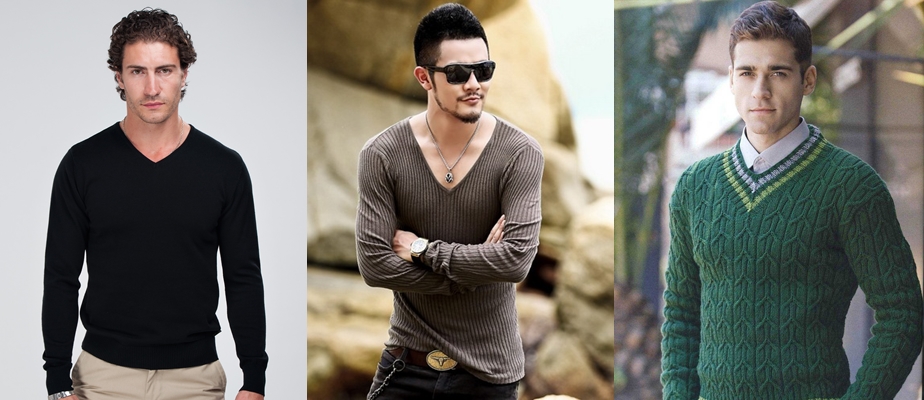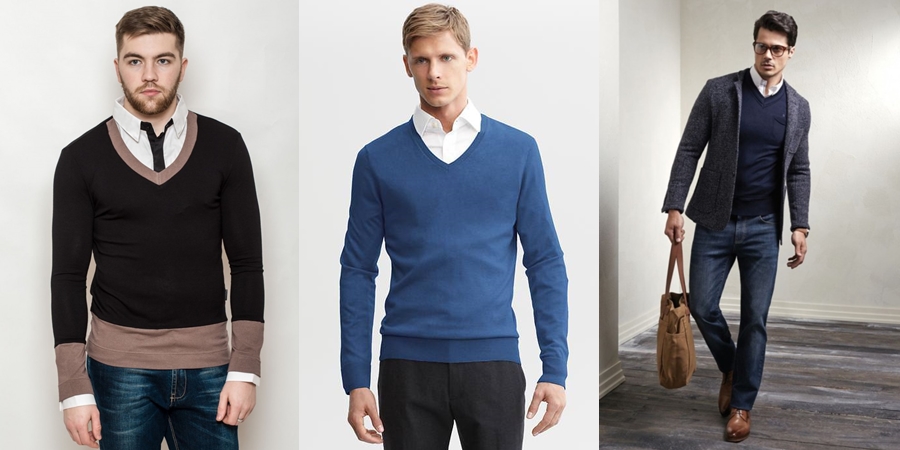Men's v-neck sweater. Why an attractive V-neck sweater
Awesome sweater for men. My research and my MK.
There is a description here, but it is not from this sweater, but something similar
Http://www.site/users/oxipin/post141529863/
I knit it like this:
I DID AN APPROXIMATE CALCULATION RIGHT IN THE PICTURE
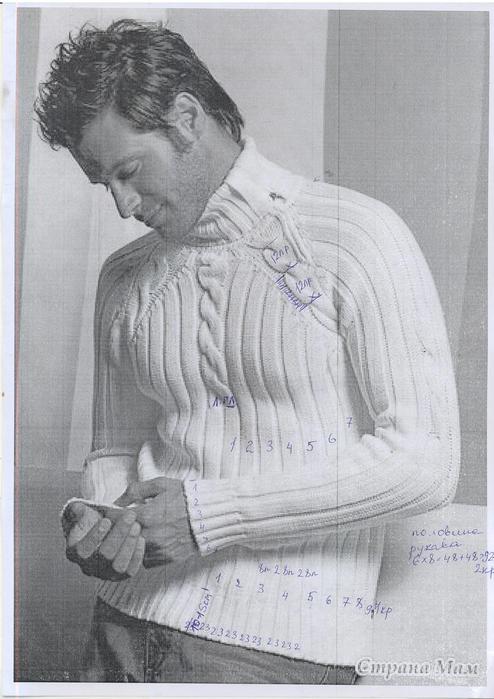
I bought Lyly 100% mercerized cotton thread. 50 g 125 m. recommendations for knitting needles No. 3.5-4 But after knitting the sample, I didn’t like it. Here I calculated the loops from the photo
Using knitting needles No. 3, I knitted 22 stitches for 27 rows with an elastic band 3*2 and an elastic band 2*2. it turned out a bit runny
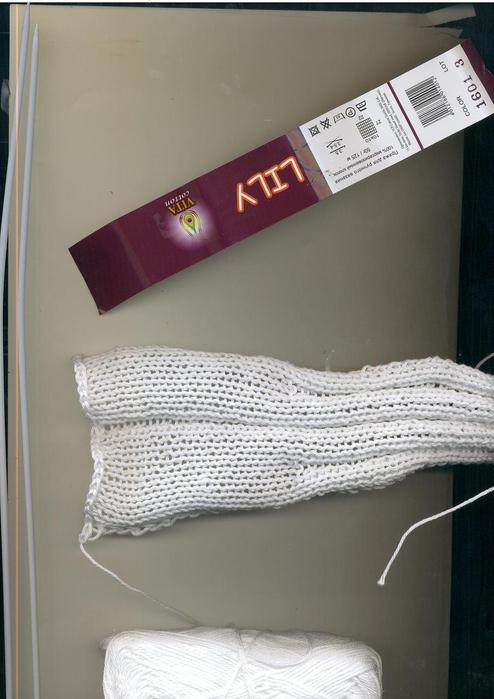
Using needles No. 2 I knitted the same number of loops, it turned out tighter.
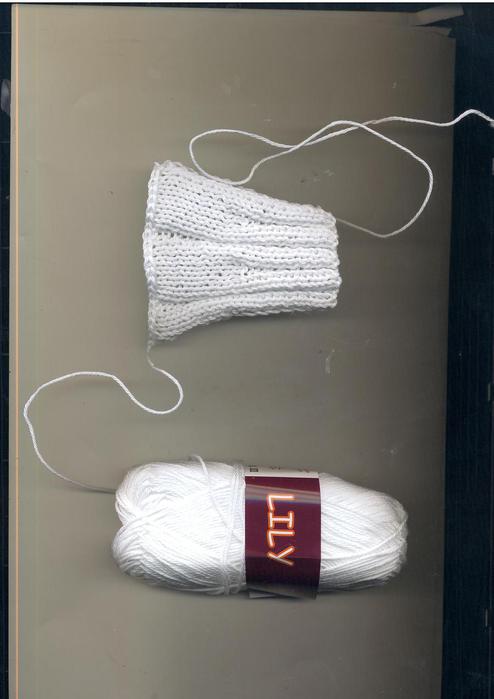
Here I knitted three samples:
1st - using knitting needles No. 3, cast on 22 stitches. 1 cr, 3 knits, 3 out. knitted 28 rows, moved to the second rib pattern, 1 kr, 8 knits, 2 out, 8 knits, 2 out. knitting needles No. 3. The size turned out like this: 22 p. 7 cm, 56 rows 20 cm
2nd - Using needles No. 2, cast on 25 stitches, 1 cr, 1 in. *3 persons, 3 from. *repeat from *and to* 3 persons, 1 cr. I also knitted 28 rows. switched to the second elastic pattern: 1 cr, 9 knits, 3 out, 9 knits, 1 cr. Knitted 28 rows. Size: 25 p. 7 cm 3 mm, 56 r 16 cm.
3rd - who needs to tie small size. Using knitting needles No. 2, cast on 22 stitches: 1 cr, *k2, k2* repeat from * to *k1, knitted 14 rows, moved to another pattern, k1, k6, k2, k6, k2, k2, 1 cr. and knitted 14 rows. Size: 22 p-7 cm 4 mm, 28 rows 8 cm.
I did not iron the samples.
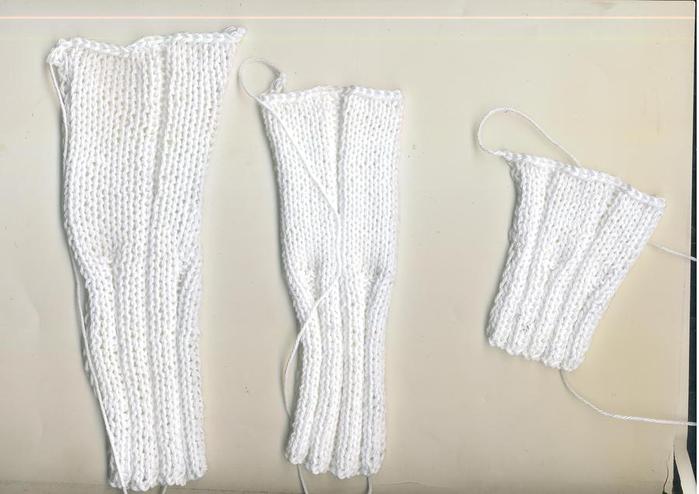
And these (someone might need) steam ironed samples
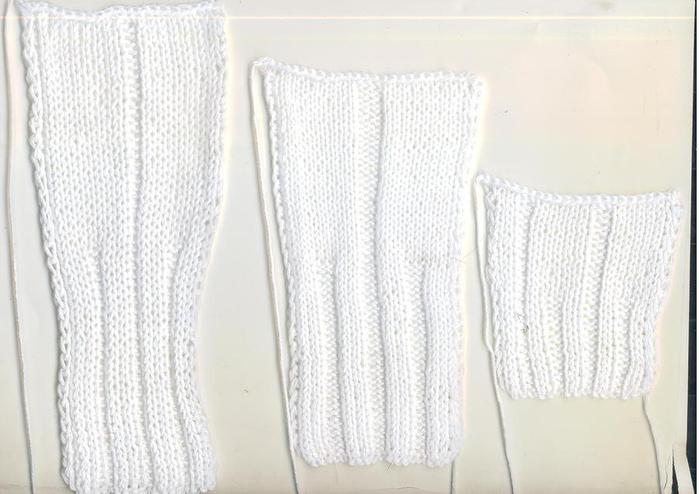
I made a calculation based on the upper and lower elastic bands:
Method 1 - bottom elastic band 3*3.
1 chrome, 2 out, =3p, *k3, p3, k3* k3. = 12 loops. 12*18=216. 216-1=215 (for the drawing), 1 cr Total: 1+2+215+1=219p It’s clear that the size will not be small. Well, unless you take an even thinner thread. Supposedly size 52-56.
Method 2 - bottom elastic band 3*2
1 chrome, 1 out, = 2p, * k3, p2, k3 * k2. = 10 loops. 10*18=180. 180-1+2 edges = 182 (for the drawing), 1 edge Total: 1+1+180-1+1=182p It’s clear that this size will not be small, but it will be smaller than the previous one. Well, unless you take an even thinner thread. Supposedly size 48 - 52.
Method 3 - bottom elastic band 2*2
1 chrome, 1 out, =2p, *k2, p2, k2* k2. = 8 loops. 8*18=144. 144-1=143 (for the drawing), 1 cr Total: 1+1+144-1+1=146p It’s clear that the size will be small. Well, unless you take an even thinner thread, then the product will turn out even smaller. This is for those who will knit a purely summer option. Presumably size 40-46.
Girls! You can also reduce the stripes, make it not 18 stripes, but 16. The dimensions should be reduced further, about 5-7 cm wide!
My husband wears size 50-52 clothes and that’s why I started knitting 182 stitches according to the second calculation.
I tied it with an elastic band 3p.*2p. 30 rows and switched to pattern 8p.*2p.
182 loops = 35 cm unsteamed fabric. and 76cm is obtained if it is stretched wide. I won't steam it. I love it when the elastic band is like an accordion.
Knitted with an elastic band 8*2 - 100 rows
I look at the braid in the center and have doubts: firstly, it decreases on the sides by 1 loop, turns into a purl. Secondly, the central two purl ones turn into the front ones and changes already occur before the braids are intertwined in rows 6, and only then the braid is intertwined. The braid begins 10 cm earlier than the raglan lines.
I switch to the central braid.
6 rows are the beginning of the braid, with the two central purls knitted with knit stitches, and 2 loops on the edges turned into knit stitches.
1-6 rows: 1 cr, 1 from, * 8 knits, 2 from * - 7 times, 1 from, braid - 16 knits, 1 from, * 2 from, 8 knits * - 7 times, 1 from. 1 cr. - 182 loops
In the 7th row, I crossed the braid 8 knits in front of the knitting needle, knitted 8 knits, and then 8 knits. I knitted it with a knitting needle.
8-22 rows: Knitted according to the pattern 1 cr, 1 from, * 8 knits, 2 from * - 7 times, 1 from, 16 knits, 1 from, * 2 from, 8 knits * - 7 times, 1 from. 1 cr.
Row 25: repeated the crossing
Row 26: purl - knit according to the pattern.
Row 27: knit - knit according to the pattern and at the same time closed the first 11 loops, armpits.
Row 28: purl - knitted according to the pattern, and at the same time closed off 11 loops from the second edge.
Central braid at front and back
1.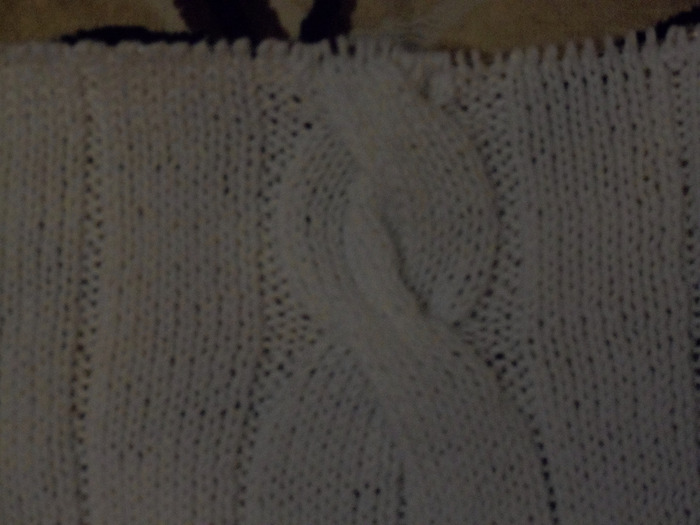
2.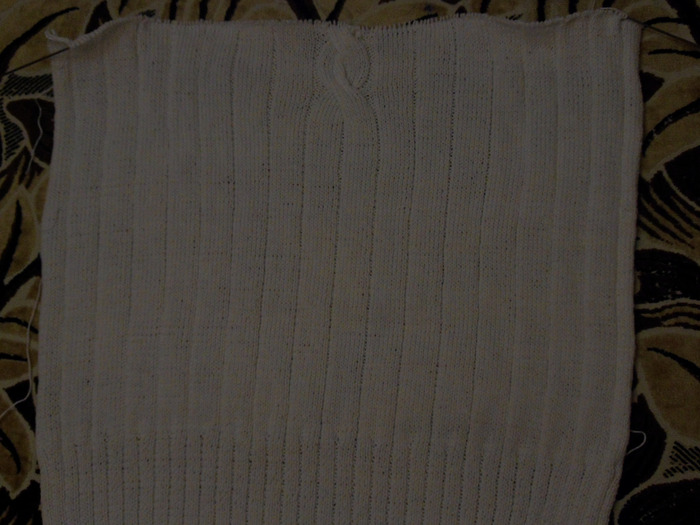
Front and back
3.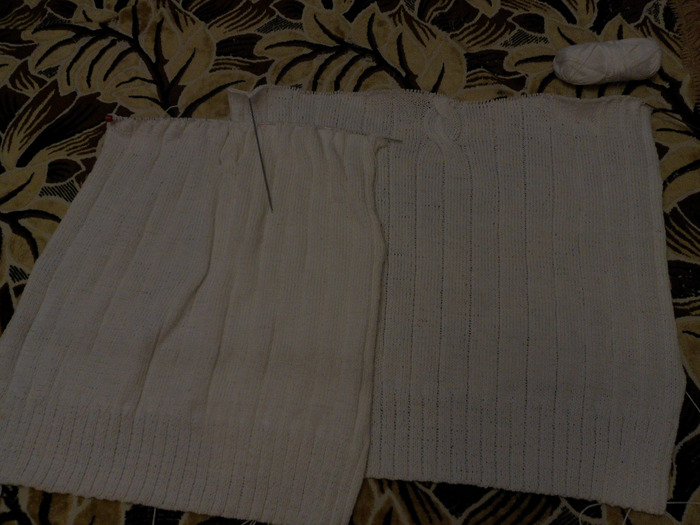
SLEEVES.
Girls, be careful! Having already knitted 110 rows of 92 loops, I had to undo it. Here's the thing. CENTRAL BRAID! It was necessary to dial 102 or 82. So that the two stripes go into a braid and there is exactly the middle. I unraveled my work into 110 rows and put the ball in the microwave to straighten the thread for 30 seconds, in three days it had already become zigzag, wish me luck!
I cast on 82 loops and will knit 30 rows with an elastic band 3*2, I started like this: 1 cr, 1 p, *3 knits, 2 from* repeat from *to* 8 times, 1 from. 1 cr. In the last purl row I added 1 stitch on both sides. I switch to the main elastic band: 1 cr, 1 out, *8 knits, 2 out* repeat from * to * 8 times, 1 out, 1 cr.
31 row - 1 cr, 2 from, * 8 knits, 2 from * repeat 8 times, 2 from, 1 cr = 84 loops.
Rows 32-38 - knit according to the pattern. in the last row add 1 loop on both sides for 86 loops.
Row 39 - 1 kr, 1 knit, 2 of, * 8 knit, 2 of * repeat 8 times, 2 of, 1 knit, 1 kr
Row 40-46 - knit according to the pattern. in the last row add 1 loop on both sides 88 loops.
Row 47 - 1 cr, k2, 2 out, *8knit, 2 out* repeat 8 times, 2 out, 2 knits, 1 cr
Rows 48-54 - knit according to the pattern. in the last row, add 1 loop on both sides for 90 loops.
Row 55 - 1 cr, k3, 2 from, *8 knits, 2 from* repeat 8 times, 2 from, 3 knits, 1 cr
Rows 56-62 - knit according to the pattern. in the last row add 1 loop on both sides for 92 loops.
Row 63 - 1 kr, 4 knits, 2 of, * 8 knits, 2 of * repeat 8 times, 2 of, 4 knits, 1 kr
Row 64-70 - knit according to the pattern. in the last row add 1 loop on both sides for 94 loops.
71 row - 1 cr, 5 knits, 2 from, *8 knits, 2 from* repeat 8 times, 2 from, 5 knits, 1 cr
72-78 row - knit according to the pattern. in the last row add 1 loop on both sides for 96 loops.
Row 79 - 1 cr, 6 knits, 2 out, *8 knits, 2 out of* repeat 8 times, 2 out of, 6 knits, 1 cr
Row 80-86 - knit according to the pattern. in the last row add 1 loop on both sides 98 loops.
Row 87 - 1 cr, 7 knits, 2 out, *8 knits, 2 out of* repeat 8 times, 2 out of, 7 knits, 1 cr
88-94 row - knit according to the pattern. in the last row, add 1 loop on both sides for 100 loops.
Row 95 - 1 cr, 8 knits, 2 of, * 8 knits, 2 of * repeat 8 times, 2 of, 8 knits, 1 cr
Rows 96-102 - knit according to the pattern. in the last row add 1 loop on both sides for 102 loops.
Row 103 - 1 cr, 1 in, 8 knits, 2 in, *8 knits, 2 in* repeat 8 times, 2 in, 8 knits, 1 in, 1 cr
Row 104-110 - knit according to the pattern. in the last row add 1 loop on both sides for 104 loops.
In every 8th row on both sides I add 1 loop 10 times
and then 30 + 80 = 110 rows, I switch to the central braid, as I knitted along the front and back. I get 102 loops. The knitting approximately reached the elbow.
I switch to the central braid
6 rows is the beginning of the braid, while the two central purl loops were knitted with knit stitches, and the 2 knit loops along the edges turned into purl loops.
1-6 rows: 1 cr, 1 from, * 8 knits, 2 from * - 8 times, 1 from, 16 knits, 1 from, * 2 from, 8 knits * - 8 times, 1 from. 1 cr.
In the 7th row, the knit side made a crossing CENTRAL BRAID (first time) - 8 knits in front of the knitting needle, knitted 8 knits, and then 8 knits. I knitted it with a knitting needle.
8-22 rows: Knitted according to the pattern 1 cr, 1 from, *8 knits, 2 from* - 8 times, 1 from, 16 knits, 1 from, *2 from, 8 knits* - 8 times, 1 from. 1 cr.
Row 23: repeated the crossing CENTRAL BRAID (second time)
Row 24: purl - knit according to the pattern.
25-38 rows: Knitted according to the pattern 1 cr, 1 from, *8 knits, 2 from* - 8 times, 1 from, 16 knits, 1 from, *2 from, 8 knits* -8 times, 1 from. 1 cr.
Row 39: repeated the crossing CENTRAL BRAID (third time)
Row 40: purl - knit according to the pattern.
Rows 41-46: 1 cr, 1 from, *8 knits, 2 from* -8 times, 1 from, 16 knits, 1 from, *2 from, 8 knits* - 8 times, 1 from. 1 cr. 6 rows at the end of the braid, with two central knit stitches knitted with purl loops, and 2 purl loops at the edges turned into knit stitches. In total, 138 loops
47 row: front - knitted according to the pattern and at the same time closed the first 11 loops, armpits. 127p.
Row 48: purl - knitted according to the pattern, and at the same time closed off 11 loops from the second edge. 116p.
Now in the row we have 1 cr, 1 knit, 2 knits, * 8 knits, 2 of, * -13 times, 2 knits, 1 of, 1 cr
Knitting continues
But I went up to the braids and went along the sleeves, tying them up to about the elbow.
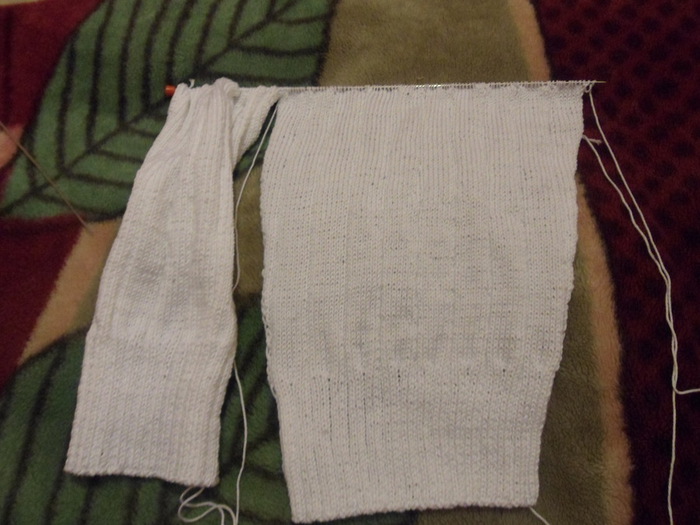
Increase from the side, evenly in every 8 rows on both sides, 1 loop.
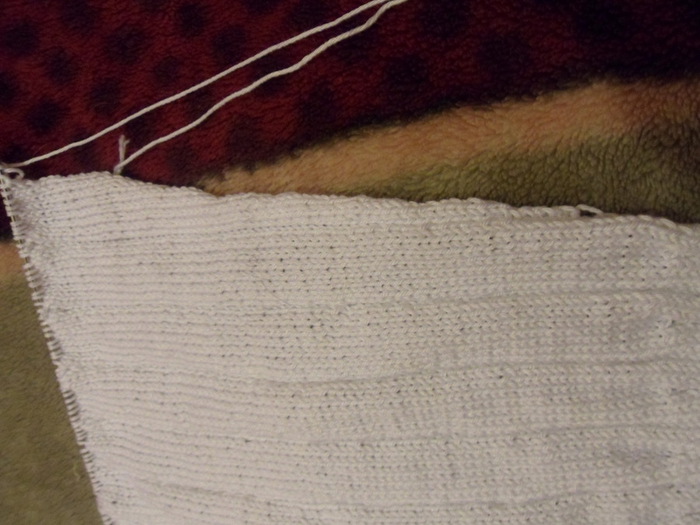
And this is the entire sleeve width of 102 loops.
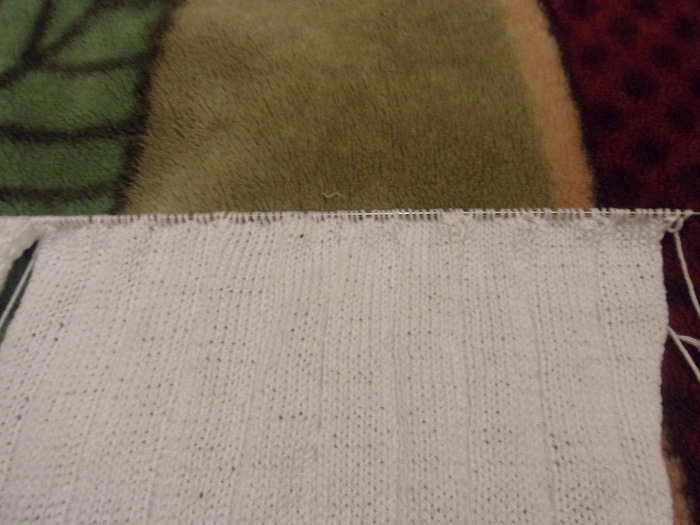
Switching to raglan and circular knitting
Do you knit sleeve+front+sleeve+back in the round? Then mark with a different color thread where the first connection was. This is the beginning and end of the series. and now do decreases in every second row.
I connected the four parts using circular knitting needles: front+sleeve+back+sleeve. Before joining, on the right side of the front, I tied a thread of a different color, knitted 8 knit stitches, and the edge stitch immediately automatically turned into the knit stitch, then 2 of them. Here the cuts began.
Tk. the hollow of the armpit requires deeper rounding, we will do this IN THE FRONT) 1 cr. knits purl then 8 loops, raglan braid line, 1 from, 2 together, knit 2 together (at this point 2 loops are decreased)
I reached the marked thread and knitted the next row - the second - simply in the round and according to the pattern, without decreasing. I repeated these two rows 10 times.
Two loops on both sides along the raglan line before and after the “BRAID” we will close off rows 5-10 in every second row (since I haven’t knitted it yet, I’m guessing, but you try it on according to your husband), then only 2 together purl You can leave the raglan line and knit the sweater to the end. If something is not clear, be sure to ask.
Don’t forget, while knitting you are knitting braids, the braids are intertwined on the 17th row (from the previous weave). I made raglan lines - braids intertwined - at the level of the braids, both along the front, sleeves and back.
This is what it looks like for me
1.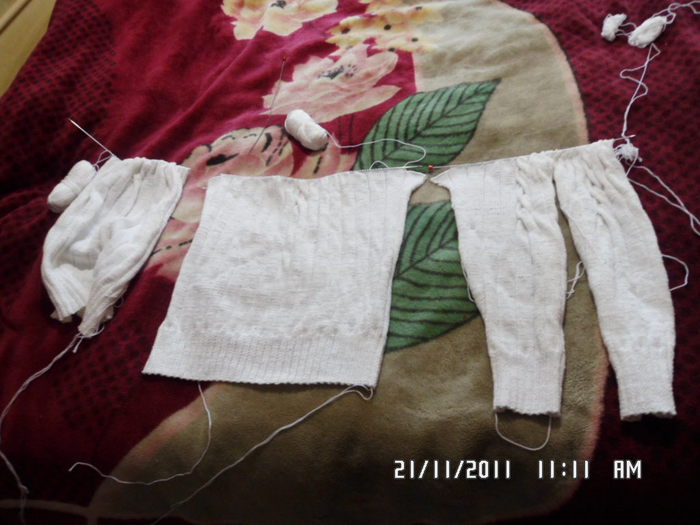
2.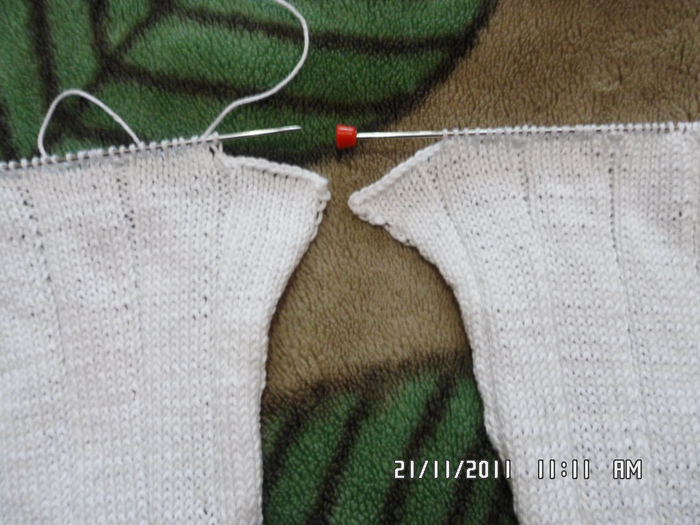
3.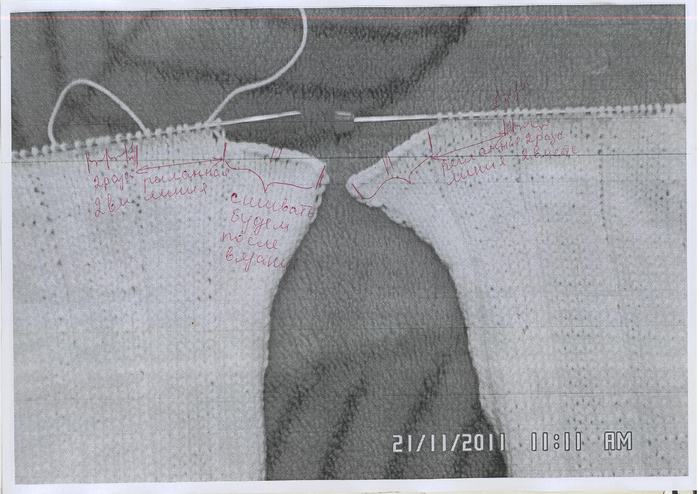
4.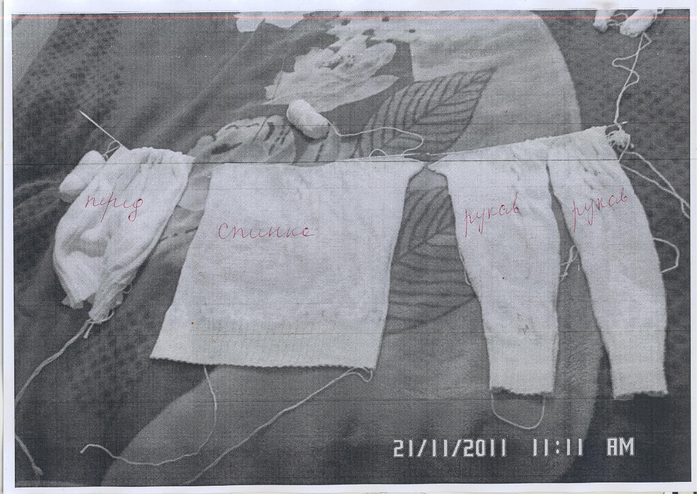
5.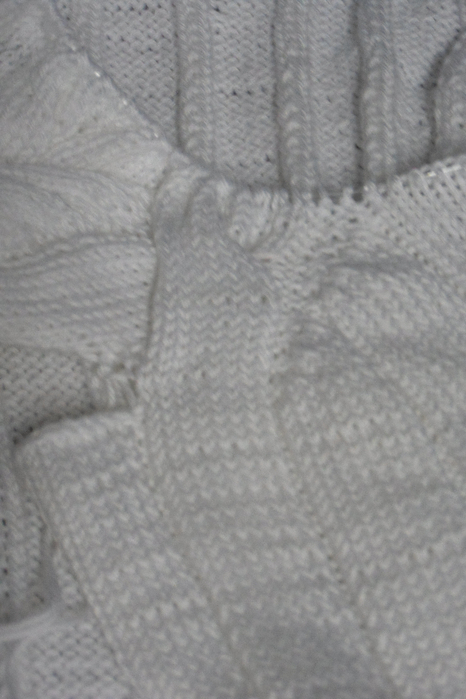
6.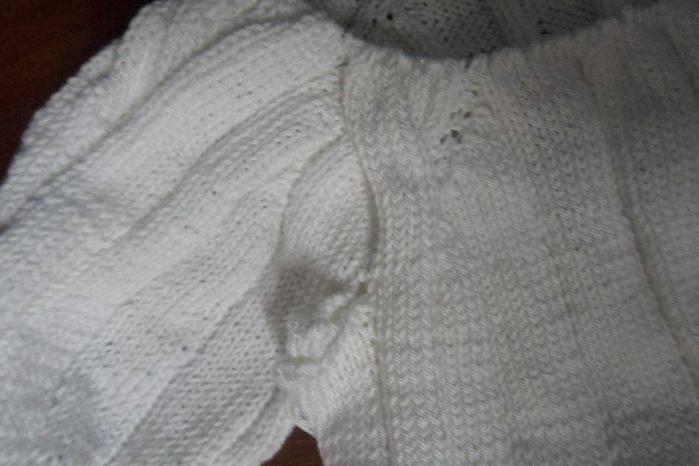
7.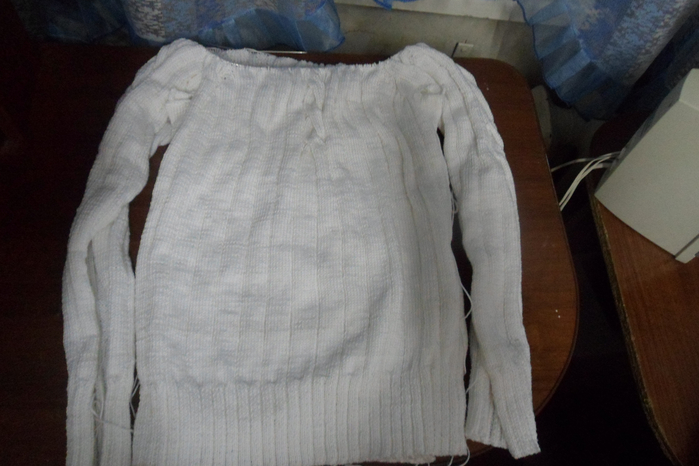
8.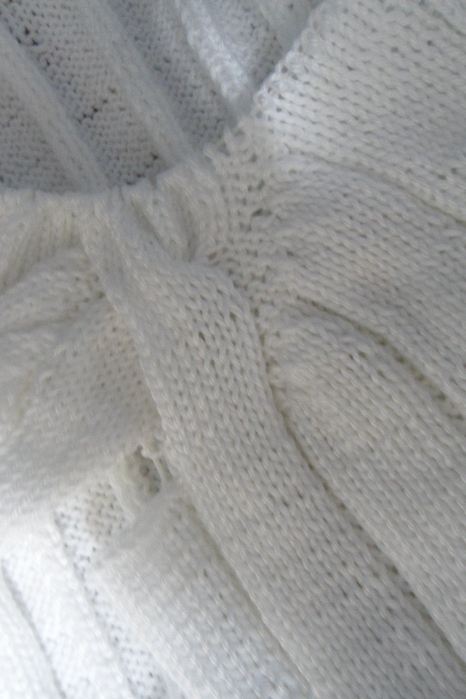
9.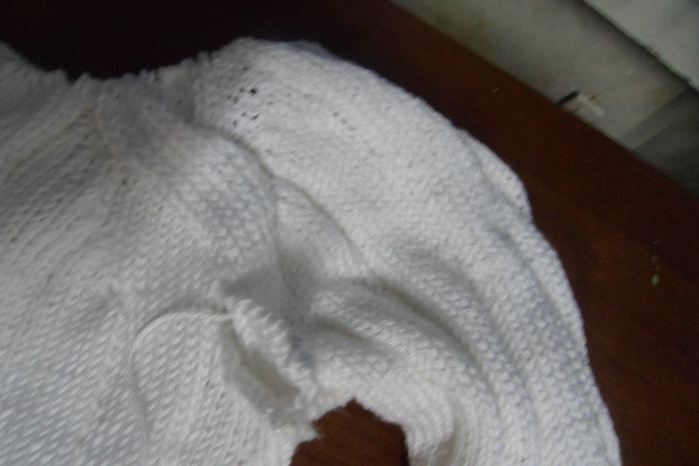
1.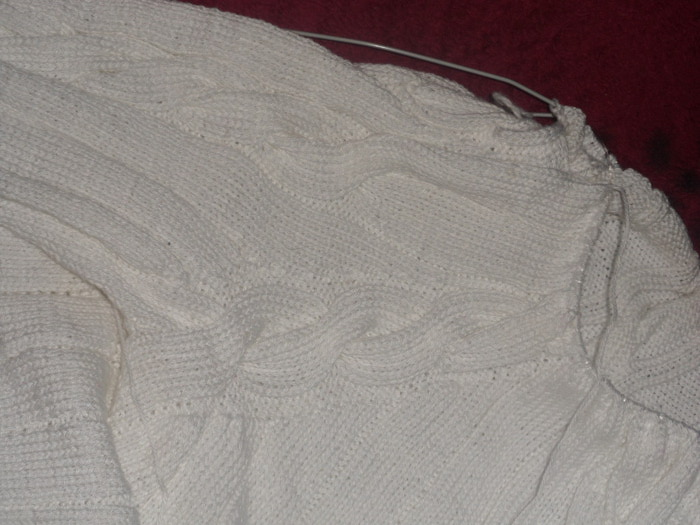
2.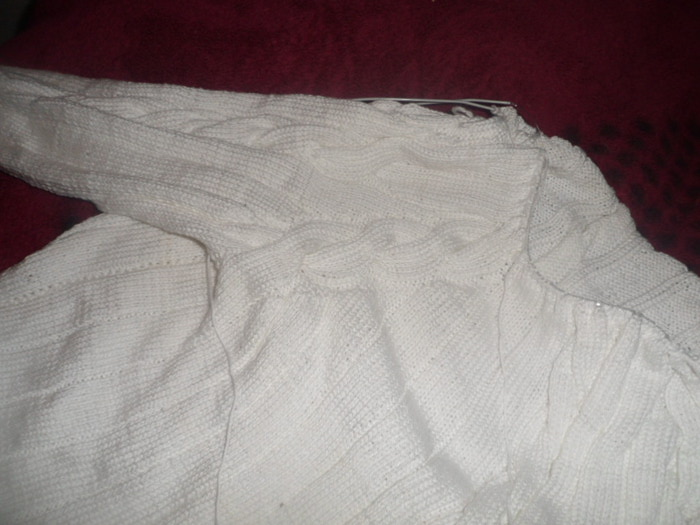
3.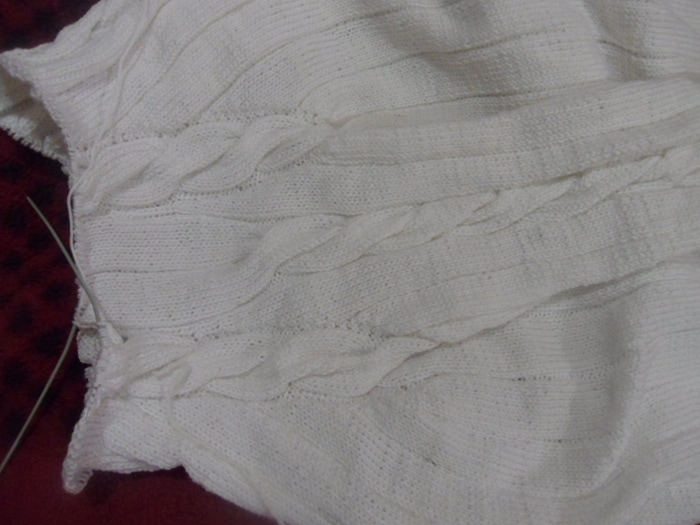
Jacket with V-neck or, as it is also called, a pullover is a type of sweater without fasteners. Classic version This product is a straight cut model with long narrow sleeves, the length of which reaches the hip line.
Sweatshirts with a V-neck became known in the 80s of the 19th century. Their prototype was knitted sweaters Irish and Scottish sailors, which they wore when setting sail. It was no coincidence that the wives of sailors chose this particular model - the lack of fasteners made the predecessors of pullovers warmer and windproof. Such sweaters were worn over body shirts.
The modern version was initially loved by English athletes. The narrow cut and pleasant material ensured their comfort during competitions. Quite quickly the fashion spread among other segments of the population.
Pullover material: what is better to choose?
Today, the fashion industry offers many models of sweaters with a V-neck - thin or thick, pastel or bright colors, with or without patterns.
Pullovers are made from cashmere, wool, cotton and various synthetic materials - polyester, acrylic, viscose.
Cotton models are attractive for their breathability, strength and wear resistance. They are also relatively inexpensive and easy to wash. Disadvantages include the possibility of shrinkage after washing, a tendency to wrinkle, as well as stretching during wear.

Cotton sweaters with a V-neck are a great option for warm autumn or cool summer.
Wool pullovers will keep you warm even in the most severe cold. They are pleasant to the touch, comfortable to wear and have a sophisticated appearance. However, be prepared for some difficulties in care - hand washing or even dry cleaning, as well as the formation of pilling.
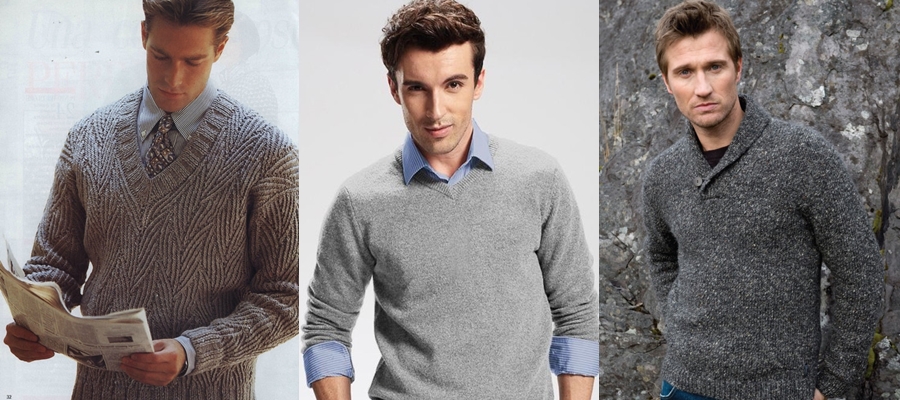
Cashmere sweaters are elegant and light, but still quite warm. Disadvantages of the model: high cost, difficulty of care and relative fragility.
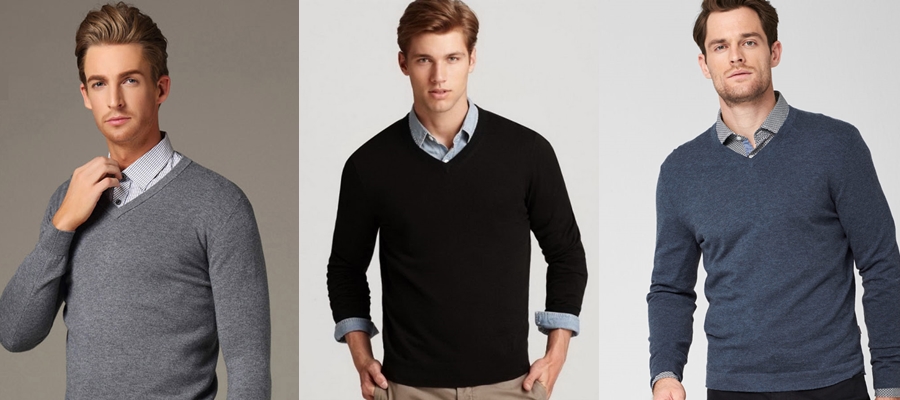
Considerable cost of products from natural materials makes many men prefer synthetic models.
- Acrylic is cheap, easy to clean and lightweight material. It warms well, although it is inferior to wool. But it can cause a lot of inconvenience to owners: such a pullover will become electrified and breathe poorly. In addition, over time, characteristic pellets will appear on the product.
- Viscose -artificial material, characterized by breathability and the ability to heat well. But wear resistance leaves much to be desired. Also, the sweater will most likely look cheap and wrinkle quickly.
- Polyester is the most common and cheapest option. Such a pullover is unlikely to warm you in winter, will not allow air to pass through, but will not require complex care, and will not stretch or shrink after washing.
- Microfiber and fleece are improved varieties of the material described above. They are highly breathable, soft, light and elastic. However, do not expect the same noble appearance, like from wool models.
Most often, pullovers are made by mixing materials: for example, 50% wool and acrylic.
Still, models containing at least 70-80% natural fabrics are preferable.
What to wear with a men's pullover
Sweatshirts with a V-neck can be safely worn for both business and casual occasions. casual style. Put them on naked body, shirts or t-shirts.
- Business option: to create a discreet look, models without decoration with a soft silhouette are suitable. Look for blue, grey, brown or black tones. In this case, the pullover is worn over a shirt; a tie would not be out of place in the look. They will approach him classic pants and shoes. A win-win combination: a light shirt with a jacket a couple of shades darker and a tie to match the sweater.

- Casual. Wear jeans or looser trousers under the pullover. For shoes, moccasins, sneakers, loafers, oxfords or boat shoes are preferable. In this option, it is permissible to wear a pullover simply on a naked body. But a jacket combined with a T-shirt will look no worse.

Secrets of choosing a quality product
- Pay attention to seams and material. The latter should be pleasant to the touch, uniform and well colored. Sticking threads in the amount of more than a couple of pieces should alert you. The lines are even and neat.
- Try to try on a pullover before purchasing. It is very important to evaluate its comfort - walk around in it, raise your hands up. An option that is too narrow or wide, by definition, will not look stylish.
- At sales, carefully examine the product for damage or pilling. Saving is good, but not at the expense of your own image.
Popular models
- Available brands: when buying a pullover in boutiques OGGI, O’stin, H&M, Savage, you can spend up to 2.5-3 thousand rubles.
- Middle segment: brands Wrangler, Henderson and Tommy Hilfige, Diesel offer models from 4-6 thousand rubles.
- The price for pullovers from brands such as Armani Jeans, StoneIsland, Kenzo, Calvin Klein and Iceberg starts from 7 thousand rubles.
A V-neck sweater will allow you to create an elegant unique image. And the variety of models will allow you to choose suitable options for all occasions.
Size: 50.
Materials: 800 g of sheep wool yarn with the addition of medium thickness sand-colored viscose; knitting needles No. 4 and 5.
Rib 1 x 1: knit alternately k1, p1. Out. R. knit according to the pattern.
Knit stitch (knit stitch): knit. R. - persons p., out. R. purl P.
Fantasy pattern: according to the scheme.
Knitting density: 10 x 10 cm = 19 p. x 26 r.
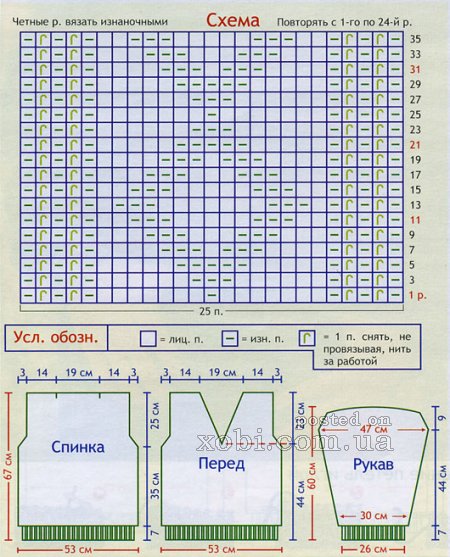
How to knit a men's knitted pullover with a V-neck.
Back
Using knitting needles No. 4, cast on 101 sts and knit 7 cm with 1x1 rib. Continue knitting with needles No. 5, distributing sts in the following manner: 6 sts. stitch, *25 sts according to pattern, knit 7 sts. stitch, repeat from * to the end of the r. and finish 25 sts according to the pattern and 6 sts. satin stitch At a height of 42 cm from the beginning of knitting, decrease for the armholes on both sides in every 2nd row, retreating 2 sts from the edge, 6 times 1 st. At a total height of 67 cm, close 27 sts for each shoulder, 35 sts for the neckline and finish knitting.
Before
Knit like a back. At a height of 44 cm for V-neck neck, remove the middle stitch with a pin and knit separately, decreasing on both sides of it in every 2nd r. 8 times 1 p. and in every 4th r. 9 times 1 p. At a total height of 67 cm, bind off 27 p. for each shoulder and finish knitting.
Sleeves
Using knitting needles No. 4, cast on 49 sts and knit 7 cm with 1x1 rib. Continue knitting with needles No. 5, evenly increasing in purl. R. 8 sts = 57 sts, knitting the first and last 16 sts. satin stitch and medium 25 stitches with a pattern according to the diagram. At the same time, add on both sides every 6th r. 16 times 1 p. = 89 p. At a height of 51 cm from the beginning of knitting, reduce the sleeves on both sides in every 2nd r., retreating 2 p. from the edge, 6 times 1 p., then close 4 times 6 stitches each and the remaining 29 stitches. Total height is about 60 cm.
Assembly
Pin the pieces onto the pattern, moisten them and let them dry. One shoulder. Along the edge of the neckline, using needles No. 4, raise 153 sts, including the middle st, knit 7 r. with an elastic band 1x1, knitting on both sides of the middle stitch in each person. R. 2 p. together purl, in each purl. R. 2 sts together. and close the item according to the drawing. Complete the remaining ones and sew the sleeves into the armholes.

